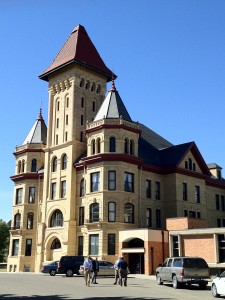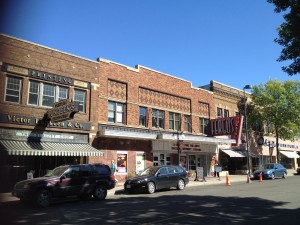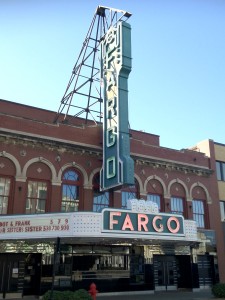One of the most interesting places I visited this past year was Fergus Falls, Minnesota. The three blogs I wrote about the former Fergus Falls State Hospital turn out to be three of the most widely read blogs I’ve written. The Fergus Falls Regional Treatment Center was one of the last Kirkbride-plan asylums built in the country and as such has inspired a national interest in its disposition. Vacant for several years now, the 900,000 square foot complex presents all of the positive and negative aspects of complexes often referred to as “white elephants.” My posts have asked if we can recycle cans why can’t we reuse the Fergus Falls Treatment Center? If Bruges, Belgium can remake an 800 year old hospital why can’t we figure out how to reuse a one hundred year old one? And if they can just hold on, won’t its durability allow Fergus Falls the time they need to find an appropriate reuse?
Why is Durability Key to both Sustainability & Preservation?

A typical connecting corridor in the historic Kirkbride-plan Fergus Falls Regional Treatment Center.
When something inherently lasts longer, its life cycle is longer. When a material like stone or a building built of stone lasts longer, it needs to be replaced less often, resulting in less impact on the planet and the environment. Most traditional buildings were built with extremely durable materials. First growth wood and marble, sandstone or limestone will typically have very long life spans. If the building’s materials are lasting longer and structurally sound, continued or adaptive use makes much more economic sense than demolition. Often the argument to save an old building can be won because of its durability rather than its cultural significance. Two projects I’m currently working on still have their original windows from the 1870s and 1880s, likely made from first-growth wood, and we are still able to restore and re-use them. So, when I look at the 900,000 square foot Fergus Falls State Hospital complex and see that it is still in sound condition, it becomes apparent that it could probably sit vacant for a decade with little deterioration; not that I recommend that. This incredibly sound and durable structure can be easily partitioned and phased since each of the ward buildings are separate buildings. I can think of at least ten different uses that could be readily inserted into the place and none of them would damage the existing fabric. So why isn’t its durability enough to keep it safe from the wrecking ball right now?
Durability Just Doesn’t Trump Vacancy Rates

The towers of the Fergus Falls Administration building remind us how durable our traditional, historic buildings are.
It is both a graceful and restful site, far enough from downtown to encourage a variety of dedicated uses and close enough to ensure the city population would visit. However, the city of Fergus Falls has a population just over 13,000 and in our current economic climate, there is little need for additional housing, commercial space or industrial space for the surrounding region. With vacant commercial space in the downtown core, the current population cannot currently support or use this large additional complex without an outside user. As a result, after much contention which can be read about in my previous postings linked above, a marketing firm was hired to manage a request for proposal process to identify potential developers. So far about a dozen potential developers have expressed interest and the city has requested a two year extension on the demolition funds that have been allocated by the state. In the meantime, a project to do a “flash” photo documentation of the site on May 4th has been approved by the city council. If you’d like to learn more about the place, this history has just been released. With these positive announcements, I am optimistic that the durability of this place will soon join with an economically feasible reuse, and unlike the Richardson Olmsted Complex, it may not take 30 years.
Two Years & Counting
As a celebration of my firm’s two-year anniversary I will be posting each day this week about places I’ve visited in the past year. My visit to Fergus Falls also gave me the bonus of my first visit to North Dakota. Fergus Falls is within an hour of Fargo, North Dakota, the largest city in North Dakota. With the next closest metropolitan area almost three hours away in the Twin Cities, Fargo is the nearest metropolitan area. It is the home of North Dakota State University and a ND-MN Metropolitan Statistical Area, which in 2010 contained a population of 212,171. I was happy to finally make it to North Dakota and check it off my state list. I spent a delightful day in downtown Fargo after my visit to Fergus Falls, admiring the revitalized streets and buildings. The core is surrounded by rings of suburban sprawl with traffic that reminded me of the Beltway. But that’s pretty common in most cities today, whether they’re in Maryland or North Dakota. And like any reactivated urban core around the country, I was able to drink tea in a cool coffee shop on the main street, admire street art, buy some soaps and post cards, peruse a midcentury furniture antique store, watch a train go by the historic train station (which has been reused as shops) and check out the restored downtown movie theatre. All in all, a perfect afternoon.
And if you’d like to “subscribe” or follow my blog, True Green Cities, please sign up through the “Subscribe” button at the bottom left of this page. You’ll receive a daily recap when new blogs are posted. Or Sign up for the Feed.


